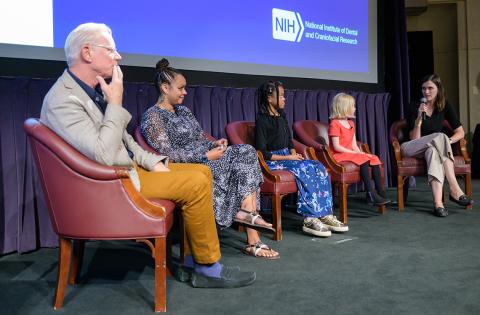25-Year Scientific Quest
Hope Offered for Patients with Rare Disorder

Seven-year-old Jianna Monchais was an enigma to doctors as an infant. Physicians struggled to explain the large birthmarks across her body and puzzled over why she started menstruating as a baby. Some years earlier, Kelly Cohen had noticed similar birthmarks on her son, Liam, who, by his fifth birthday, had broken his femur—the strongest bone in the body—multiple times.
Jianna and Liam have fibrous dysplasia/McCune Albright Syndrome (FD/MAS), a rare disease of the skeleton, skin and endocrine system. Marked by weak, malformed bones, early puberty and birthmarks, the disease can cause immense pain, disability and diminished quality of life.
Both families found answers and expert care over the years from clinician-scientists at NIH. Recently, several families visited NIH to participate in a symposium “Fibrous Dysplasia/McCune-Albright Syndrome: Celebrating 25 Years of NIDCR Research.”
“I’ve never felt so cared for,” said Jianna’s mother Voncia Monchais, about their first consultation with Dr. Alison Boyce, pediatric endocrinologist at the National Institute of Dental and Craniofacial Research (NIDCR). “Dr. Boyce said, ‘We have this team for her and she’s going to have this team for her life’ and that has brought all the comfort.”
Boyce and her colleagues at NIDCR are world-renowned leaders in FD/MAS research and key members of the NIDCR scientific program that has focused on the disease for 25 years.
As part of NIDCR’s 75th anniversary, the symposium celebrated the program’s legacy and highlights its future. The event featured talks from Nobel Laureate Dr. Brian Kobilka of Stanford University; former Director of the National Institute of Diabetes and Digestive and Kidney Diseases (NIDDK) Dr. Allen Spiegel; FD/MAS scientific leaders; patients; and patient advocates.
Tracing the Root
Spiegel recounted his work on diseases that arise from mutations in a family of proteins called G proteins, and their corresponding receptors, called G-protein-coupled receptors.
In 1991, Spiegel’s team at NIDDK found that a mutation in one member of the G protein family —Gαs—causes the skin and hormonal effects of FD/MAS. But, he wondered, does it also cause the skeletal abnormalities, and if so, how? To find out, Spiegel visited NIDCR Bone Stem Cell Biologist Dr. Pamela Robey with a box full of bone samples collected from patients with FD/MAS.
“My first impression when I was looking down the microscope was ‘This is a disease of bone [stem] cells that have gone wild,’” Robey recalled during her presentation. Unlike healthy bone, the diseased bone was disorganized, poorly mineralized and riddled with scar-like fibrous tissue.
Soon after Spiegel’s visit, Robey and her colleagues discovered that the Gαs mutation impairs skeletal stem cells’ ability to develop into mature bone cells. The mutation-carrying cells multiply rapidly and form immature bone that doesn’t quite harden, resulting in weak, breakable regions throughout. These faulty patches, or lesions, can also expand and press against organs and nerves, impairing vision, hearing and breathing.
Currently, there are no approved drugs to slow or curb the growth of bone lesions.
The Search for a Bone Treatment

Given NIDCR’s expertise in bone biology, Robey saw an opportunity to better understand the skeletal aspects of FD/MAS and develop treatments. Along with NIDCR Endocrinologist Dr. Michael Collins, she launched a research project called a natural history study to document the nature and progression of the disease.
Since its launch in 1998, the study has enrolled more than 300 patients ages 1 to 102.
Collins explained how the study has revealed that bone lesions tend to develop before age 15, suggesting that an effective treatment, if administered early, may help prevent the most serious impacts of FD/MAS. Results from the study have also led to better standards of care, including showing that certain surgical procedures might be unnecessary and even harmful.
Patients with FD/MAS also have excessive bone turnover, the process by which old bone is continually replaced with new bone. Dr. Mara Riminucci from Sapienza University, Italy, showed that blocking RANKL, a protein responsible for excessive bone turnover, can prevent the formation of new bone lesions in mice. The study added to evidence that an FDA-approved RANKL-blocking osteoporosis drug called denosumab might hold promise for patients.
Boyce shared how that hypothesis was tested in a recent NIDCR clinical trial. Eight adults with FD/MAS were given denosumab, which markedly reduced abnormal bone turnover—an indication of improved bone quality and strength. Her team is now testing whether early intervention with denosumab in children can prevent FD/MAS lesions from forming in the first place.
Beyond FD/MAS Research
The final speaker, Kobilka, described his Nobel-winning research on the receptor family at the heart of FD/MAS—G-protein-coupled receptors. About half of all approved drugs act on this group of receptors, including antihistamines, antidepressants and opioids.
Citing his research to develop nonaddictive opioids as an example, Kobilka highlighted the progress, challenges and opportunities in G-protein-coupled receptor drug discovery. These principles may help guide the discovery of therapeutic molecules that act on the faulty Gαs protein underlying FD/MAS.
“We move from a place of uncertainty to one of hope, from limited treatment options to a future where personalized therapies are within reach,” said NIDCR Director Dr. Rena D’Souza, who closed out the event. “Fibrous dysplasia/McCune-Albright is no longer an insurmountable challenge but a field ripe with possibilities.”
To watch the event in full, visit https://videocast.nih.gov/watch=49386.
